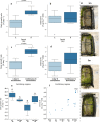Effects of season, depth and pre-cultivation fertilizing on Ulva growth dynamics offshore the Eastern Mediterranean Sea
- PMID: 37679404
- PMCID: PMC10485012
- DOI: 10.1038/s41598-023-41605-4
Effects of season, depth and pre-cultivation fertilizing on Ulva growth dynamics offshore the Eastern Mediterranean Sea
Abstract
Offshore macroalgae production could provide an alternative source of biomass for food, materials and energy. However, the offshore environment in general, specifically the Eastern Mediterranean Sea (EMS) offshore, is a high energy and low nutrients environment, thus challenging for macroalgae farming. In this study, we experimentally investigated the impact of season, depth, and pre-cultivation fertilization duration on the growth rates and chemical composition of offshore Ulva biomass, and developed a predictive model tailored to offshore conditions, capable of estimating both biomass growth rate and nitrogen content. Specifically, we measured Ulva biomass growth rate and internal nitrogen in the nitrogen-poor EMS a few kilometers offshore the Israeli coast at various depths and on-shore pre-cultivation fertilization schedules. Based on these data, we constructed a predictive cultivation model of Ulva offshore growth, which allows for the optimization of fertilization requirements for offshore cultivation. This study provides new insights on the effects of seasonality, depth, and pre-cultivation fertilization duration on growth rates and chemical composition of offshore Ulva sp. biomass production.
© 2023. Springer Nature Limited.
Figures



References
-
- Lehahn Y, Ingle KN, Golberg A. Global potential of offshore and shallow waters macroalgal biorefineries to provide for food, chemicals and energy: Feasibility and sustainability. Algal Res. 2016;17:150–160.
-
- Hurtado, A., Concepcion, A., Duinker, A., Tiwari, B., Elvevoll, E.O., Yukawa, G., Levine, I.A., Banach, J.L., Sato, J., Hayes, M. & Hansen, M. ReportoftheExpertMeetingonFoodSafetyforSeaweed—CurrentStatusandFuturePerspectives. (2022).
-
- Roesijadi, G., Jones, S. B., Snowden-Swan, L. J. & Zhu, Y. MacroalgaeasaBiomassFeedstock:APreliminaryAnalysis(PNNL-19944). (2010).
-
- Pimentel M, Pimentel MH. Food, Energy, and Society. CRC Press; 2008.
-
- Pimentel D. Global Economic and Environmental Aspects of Biofuels. CRC Press; 2012.
Publication types
MeSH terms
Substances
LinkOut - more resources
Full Text Sources

